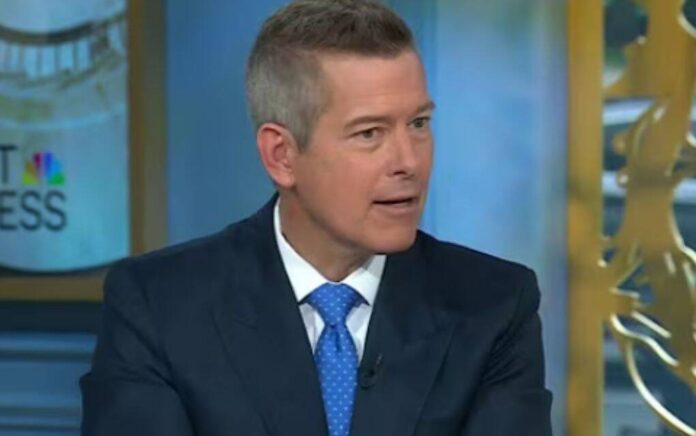
The Trump admin is about to step on a landmine. It will turn the American people against them.
That’s why the White House is in a secret panic over this huge crisis brewing behind the scenes.
Trouble In The Skies With America’s Airports Struggling To Find Parts
The American air traffic control system is teetering on the edge of disaster, with a deadly midair collision, repeated outages, and a critical staffing shortage exposing deep vulnerabilities. The Trump administration, now tasked with steering the nation through this crisis, faces intense pressure. Transportation Secretary Sean Duffy has sounded the alarm, revealing a shocking reality: the Federal Aviation Administration (FAA) is scouring eBay and resorting to 3D printers to replace parts for obsolete computer systems. For an administration that champions American strength and competence, ensuring safe skies is non-negotiable—failure here risks eroding the trust of the American people.
Duffy laid bare the dire state of the nation’s air traffic infrastructure during a Senate Appropriations Committee hearing on Thursday. The technology underpinning America’s airports is so outdated that reliable suppliers for critical components are virtually nonexistent. This isn’t a minor inconvenience; it’s a systemic failure that threatens the safety of millions who fly every day. The administration’s ability to address this crisis swiftly will define its credibility on delivering practical, results-driven governance.
“We do try to buy replacement parts on eBay for this really old equipment,” Duffy told the senators. “Sometimes, we can’t even buy it on eBay, so we’re trying to use 3D printing to craft replacement parts for the system that we use.” These words should send a chill through every American who steps onto a plane. The Trump administration, with its focus on cutting through bureaucratic red tape, must prioritize a robust overhaul to prevent this from becoming a political liability.
Duffy first highlighted this issue in a CBS News interview last week, noting that the FAA turned to eBay because “we can’t buy parts for new” for its aging equipment. This isn’t just a quirky anecdote—it’s a symptom of decades of neglect that the Trump administration must now confront. The American people expect their government to ensure safe, reliable transportation, and any misstep could fuel skepticism about the administration’s competence. With air travel being a cornerstone of the economy, the stakes couldn’t be higher.
Recognizing the gravity of the crisis, Duffy unveiled a three-year plan earlier this month to modernize air traffic control systems. The proposal focuses on upgrading communications technology, surveillance systems, and digitization—critical steps to bring America’s airports into the 21st century. To fund this ambitious overhaul, the administration will seek “upfront appropriations” from Congress. This proactive approach aligns with the Trump administration’s commitment to decisive action, but it must be executed flawlessly to maintain public confidence.
The plan emphasizes that rapid modernization is essential to mitigate risks, particularly as air traffic surges and commercial spaceflight gains momentum. “A slow-paced modernization poses a higher risk because it extends the lifespan of unreliable, inefficient systems, amplifying safety, economic, and security vulnerabilities in the era of growing air traffic and cyber threats,” the proposal reads. “Rapid, safe, well-managed modernization, despite short-term challenges, is less risky as it aligns with growing aviation demands and global standards.” The administration’s focus on speed and safety is commendable, but it must deliver tangible results to avoid perceptions of overpromising.
The urgency of this modernization effort comes into sharp focus after the tragic midair collision in Washington, D.C. earlier this year, which claimed 67 lives. The crash, involving an Army Black Hawk helicopter and an American Airlines regional jet near Ronald Reagan National Airport, exposed the fragility of the nation’s air traffic control systems. It was a defining moment for Duffy’s early tenure and a wake-up call for the Trump administration. The American people are watching closely, and any further incidents could shake their faith in the administration’s ability to keep them safe.
Adding to the crisis, a series of outages at major airports has heightened concerns. At Newark International Airport, multiple incidents since late April have disrupted air traffic across the East Coast. On April 28, controllers lost radar and communications for about a minute due to an outage at the Philadelphia Terminal Radar Approach Control (TRACON). Similar failures occurred on May 9 and again on Sunday, though a backup system mitigated the latter. These disruptions, while brief, reveal a system stretched to its breaking point—a problem the Trump administration must address to prove its commitment to public safety.
The crisis isn’t limited to the East Coast. On Thursday, Denver International Airport’s traffic controllers lost contact with pilots for up to six minutes due to a radio frequency outage at the Denver Air Route Traffic Control. This facility, one of only 22 nationwide, oversees airspace across nine states. Sources told Denver7 that four radio frequencies were already inoperative, forcing controllers to rely on a single backup frequency that ultimately failed. Such failures are unacceptable, and the Trump administration must act decisively to prevent them from becoming a pattern that undermines its credibility.
The D.C. crash and subsequent outages have brought renewed scrutiny to the FAA’s staffing shortages and safety protocols. A January report from the National Airspace System Safety Review Team, issued 14 months before the collision, warned of “challenges, in the areas of process integrity, staffing, and facilities, equipment, and technology, all have ties to inadequate, inconsistent funding.” The report highlighted how staffing shortages and quality control issues were increasing safety risks—a warning that went unheeded until tragedy struck. The Trump administration must now show it can tackle these systemic issues head-on.
On the day of the D.C. crash, an air traffic control supervisor reportedly allowed a controller to leave early, leaving another to juggle both helicopter and plane traffic—a decision that contributed to the disaster. “Overtime is at a historically high level and increasing,” the safety report noted. “High rates of overtime for extended periods introduce risk into the NAS. Several associated issues include absenteeism, lower productivity and fatigue.” These staffing challenges are a critical test for the Trump administration, which must ensure the FAA is adequately resourced to protect American travelers.
The FAA’s chief operating officer, Franklin McIntosh, revealed another alarming lapse during a Senate Commerce Committee hearing on Wednesday. A dedicated hotline between the Pentagon heliport and Reagan airport, crucial for coordinating air traffic, has been inoperative since 2022 due to construction at the Pentagon. “We were not aware, but we became aware after that event. And now that we became aware of that event, we’re insisting upon that line to be fixed before we resume any operations out of the Pentagon,” McIntosh said. This oversight is a stark reminder of the attention to detail the Trump administration must bring to this crisis.
President Trump, who took office just days before the D.C. crash, has made modernizing air traffic control a priority. “I think what is going to happen is we’re all going to sit down and do a great computerized system for our control towers,” he said. “Brand new—not pieced together, obsolete.” This vision for cutting-edge technology aligns with the administration’s promise to restore American greatness, but it must be backed by action to maintain public trust.
The administration’s response to this crisis will be a defining moment. Duffy himself acknowledged the gravity of the situation, stating, “We should’ve paid way more attention to it as a country. We’ve let [the air traffic system] age, and now we’re seeing the cracks of that age play out in real time for us.” The American people are counting on the Trump administration to fix these cracks before they widen into catastrophes.
The repeated outages and the D.C. tragedy have exposed a system on the brink. With air travel demand rising and the complexities of spaceflight adding new challenges, the Trump administration cannot afford to let this issue fester. Modernizing the FAA’s technology and addressing staffing shortages must be top priorities to ensure safe skies and preserve public confidence.
For an administration that thrives on big promises and delivering results, the air traffic control crisis is a critical test. The American people deserve a transportation system that is safe, reliable, and modern—not one held together by eBay parts and 3D-printed fixes.



















